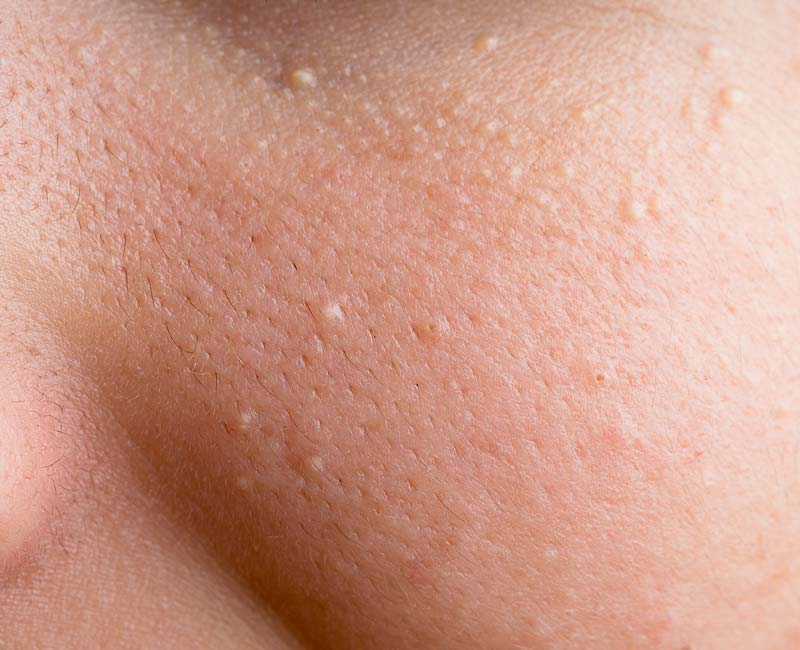Milia is a common skin condition that causes small white bumps (cysts) under the surface of your skin. About 40% to 50% of U.S. newborns have milia. Adults can get milia too. Treatment isn’t necessary because milia are harmless and go away on their own. The condition usually only lasts a few weeks.

Milia (milk spots) are small, white cysts on your skin. Cysts are filled pockets under the surface of your skin. The most common place to find milia are on your face. Milia are harmless and only affect your appearance.
It’s common to confuse the white bumps on your face with whiteheads, which are a type of acne. Milia aren’t a type of acne.
“Milia” is the plural word for the small cysts called milk spots. One cyst is called a “milium.” A milium is also known as a single milk spot or an oil seed.
Cleveland Clinic is a non-profit academic medical center. Advertising on our site helps support our mission. We do not endorse non-Cleveland Clinic products or services. Policy
There are different types of milia including:
Milia are most common among infants, but different types of milia can affect anyone at any age. About half of all healthy infants have milia when they’re born. Milia can appear later during infancy among premature babies.
Milia are harmless and only cause temporary cosmetic changes to your body or your newborn’s body. Small white bumps (cysts) form on your skin or your baby’s skin. These cysts usually disappear on their own after a few weeks.
Symptoms of milia include:
Depending on the type of milia, some can be itchy or form on a raised patch of skin.
Milia affects the skin on your body. They’re often located on your face. The most common places to find milia on your body include:
Trapped dead skin cells that form cysts below the surface of your skin cause milia. Your body naturally gets rid of dead skin cells by shedding them to make room for new cells to grow and take their place. When your old skin cells don’t fall off of your body, new skin grows on top of them and traps them underneath. Your dead skin cells harden and turn into cysts.
Additional causes of milia include:
No, milia aren’t contagious and they don’t spread from person to person.
Your provider can diagnose milia after a physical exam to learn more about your symptoms. A visual exam of the cysts on your skin leads to an accurate diagnosis and tests aren’t usually necessary, especially among newborns. If your provider needs to further examine your skin, they may request a skin biopsy. For this test, your provider will remove a small piece of your skin to examine it under a microscope.
Milia don’t need treatment because they’re not harmful. If you don’t like how milia look on your skin, talk to your healthcare provider about removing them. Treatment to remove milia could include:
You shouldn’t try to squeeze or scrape off milia on your own, as you might do with a pimple. This can scar your skin or cause an infection. There are things you can do at home that can help:
In babies, milia usually last for a few weeks after they’re born. Adults can have milia for a few weeks to a couple of months before they clear up on their own. If you prefer to get rid of milia faster, talk to your healthcare provider.
You can’t prevent most cases of milia, especially neonatal milia. You can reduce your risk of developing certain types of milia that occur later in life by:
For newborns, milia are very common and affect nearly half of all babies. The bumps on your baby’s skin are harmless and will go away on their own after a few weeks.
If you have milia and the bumps on your skin aren’t clearing up on their own, talk to your healthcare provider. They might suggest you visit a dermatologist or try new exfoliating techniques to help milia go away faster.
Some types of milia can last longer than a few weeks to months. Don’t try to pick at the bumps on your skin or try to squeeze them. This can lead to permanent scarring or an infection.
If your or your baby’s milia isn’t improving after a few months, visit your healthcare provider. If your milia get worse or you don’t like how milia look on your skin, your healthcare provider can help offer treatment to clear up your skin.
While neonatal milia and baby acne may look similar, they’re different conditions. Milia is present at birth. The condition causes cysts of dead skin cells to form below the surface of your baby’s skin. Baby acne causes small, red bumps or pustules on your baby’s face and scalp. Baby acne appears two weeks after your baby is born. Milia isn’t a type of acne.
A note from Cleveland Clinic
You don’t need to worry about small white bumps that form on your newborn’s skin. These are normal. Milia is a harmless condition that temporarily affects your appearance and the texture of your skin. The condition doesn’t need treatment and usually goes away on its own after a few weeks. Talk to your provider if your skin or your baby’s skin isn’t clearing up after several weeks.
Last reviewed by a Cleveland Clinic medical professional on 08/10/2022.
Learn more about our editorial process.
Cleveland Clinic is a non-profit academic medical center. Advertising on our site helps support our mission. We do not endorse non-Cleveland Clinic products or services. Policy